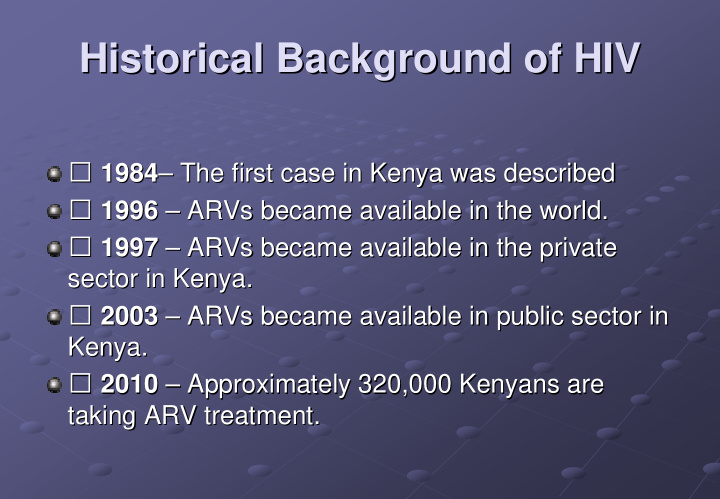



Historical Background of HIV Historical Background of HIV 1984 1984 – – The first case in Kenya was described The first case in Kenya was described 1996 1996 – – ARVs became available in the world. ARVs became available in the world. 1997 1997 – – ARVs became available in the private ARVs became available in the private sector in Kenya. sector in Kenya. 2003 2003 – – ARVs became available in public sector in ARVs became available in public sector in Kenya. Kenya. 2010 2010 – – Approximately 320,000 Kenyans are Approximately 320,000 Kenyans are taking ARV treatment. taking ARV treatment.
HIV Prevalence by Gender HIV Prevalence by Gender (age 15- -64) 64) (age 15 7.1% (1.4 million) Kenyans age 15-64 are infected with HIV. % HIV Infected % HIV Infected TOTAL FEMALES MALES TOTAL FEMALES MALES 7.1 8.4 5.4 7.1 8.4 5.4
HIV prevalence in Kenya by province, KAIS 2007 E a st e r n 4 . 6 % R i f t Va ll e y 6 . 3 % W e st e r n 5 . 4 % N o r t h Ea st e r n 0 . 8 % Ce n t r a l 3 . 6 % N y a n z a 1 4 . 9 % N a i r o b i 8 . 8 % Co a st 8 . 1 %
4 in 5 of HIV infected do not know their status Aprox.390,000 need ART 37% who need ART know their status 18.0% have CD4<250 & are not on ART
Young women between ages 15 and 34 are disproportionately infected compared to young men. KAIS Females 16 KAIS Males ) HIV Prevalence (% 12 8 4 0 15-19 20-24 25-29 30-34 35-39 40-44 45-49 50-54 55-59 60-64
MODES OF TRANSMISSION Transmission route % Sexual intercourse 80-90 Mother-to-child-transmission 5-10 Blood transfusion 3-5 Injecting drug use <5 Health care – e.g.: needle stick injury <0.01
Modes of transmission Modes of transmission
NATIONAL HIV PREVALENCE –KAIS 2007 Adults 15- -64 64 URBAN RURAL Adults 15 URBAN RURAL year old year old Male 6.2 5.5 Male 6.2 5.5 Female 10.8 8.2 Female 10.8 8.2 TOTAL 400,000 1 MILLION TOTAL 400,000 1 MILLION TOTAL% 30% 70% TOTAL% 30% 70%
Epidemiology/Impact of HIV/AIDS in Epidemiology/Impact of HIV/AIDS in Kenya Kenya 60% medical beds 60% medical beds 40% Paediatric Paediatric beds beds 40% >50% TB patients – – HIV + HIV + >50% TB patients >25% STI patients – – HIV+ HIV+ >25% STI patients Health workers face both the medical and Health workers face both the medical and social challenges of HIV/AIDS on a daily basis social challenges of HIV/AIDS on a daily basis
Accurate Knowledge of HIV Status Accurate Knowledge of HIV Status among KAIS HIV- -Infected Participants Infected Participants among KAIS HIV 2% missing 16% accurate knowledge of HIV status 26% believe themselves 57% never uninfected tested for based on last HIV 83% of all HIV- HIV test infected participants do not know their status. Denominator: All HIV infected participants
Magnitude of HIV in Pregnant women in Kenya . Estimated population 2010: 38 million . Estimated births per year: 1.5-1.7M million . Estimated HIV prevalence: 6.7% . Estimated HIV exposed births per year: 100,500- 113,900 . MTCT with no interventions: 40% or 40,200- 45,560
Recommend
More recommend